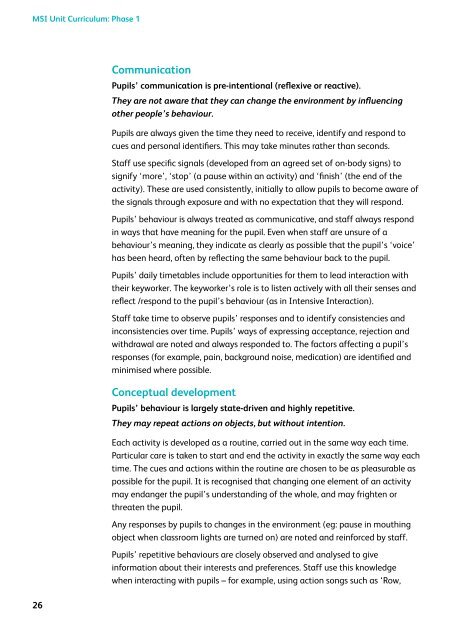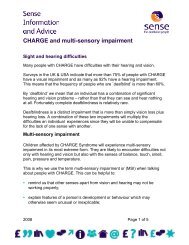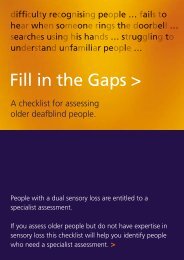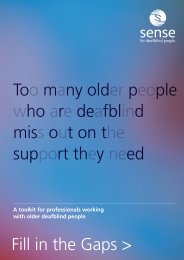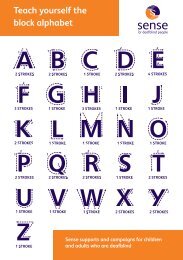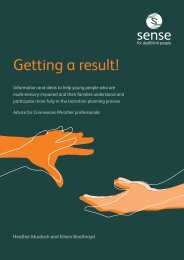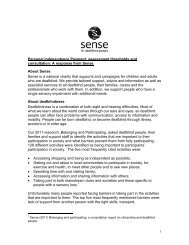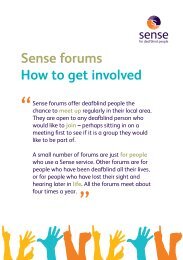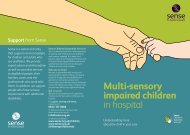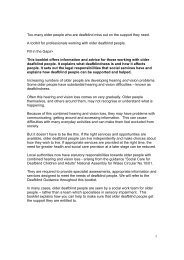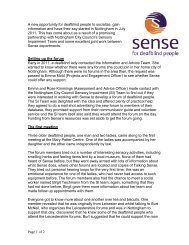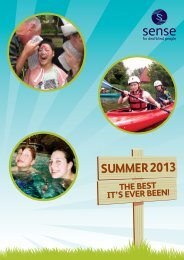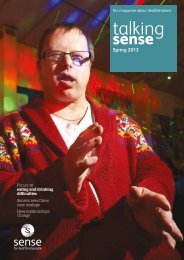MSI Unit Curriculum - Sense
MSI Unit Curriculum - Sense
MSI Unit Curriculum - Sense
You also want an ePaper? Increase the reach of your titles
YUMPU automatically turns print PDFs into web optimized ePapers that Google loves.
<strong>MSI</strong> <strong>Unit</strong> <strong>Curriculum</strong>: Phase 126CommunicationPupils’ communication is pre-intentional (reflexive or reactive).They are not aware that they can change the environment by influencingother people’s behaviour.Pupils are always given the time they need to receive, identify and respond tocues and personal identifiers. This may take minutes rather than seconds.Staff use specific signals (developed from an agreed set of on-body signs) tosignify ‘more’, ‘stop’ (a pause within an activity) and ‘finish’ (the end of theactivity). These are used consistently, initially to allow pupils to become aware ofthe signals through exposure and with no expectation that they will respond.Pupils’ behaviour is always treated as communicative, and staff always respondin ways that have meaning for the pupil. Even when staff are unsure of abehaviour’s meaning, they indicate as clearly as possible that the pupil’s ‘voice’has been heard, often by reflecting the same behaviour back to the pupil.Pupils’ daily timetables include opportunities for them to lead interaction withtheir keyworker. The keyworker’s role is to listen actively with all their senses andreflect /respond to the pupil’s behaviour (as in Intensive Interaction).Staff take time to observe pupils’ responses and to identify consistencies andinconsistencies over time. Pupils’ ways of expressing acceptance, rejection andwithdrawal are noted and always responded to. The factors affecting a pupil’sresponses (for example, pain, background noise, medication) are identified andminimised where possible.Conceptual developmentPupils’ behaviour is largely state-driven and highly repetitive.They may repeat actions on objects, but without intention.Each activity is developed as a routine, carried out in the same way each time.Particular care is taken to start and end the activity in exactly the same way eachtime. The cues and actions within the routine are chosen to be as pleasurable aspossible for the pupil. It is recognised that changing one element of an activitymay endanger the pupil’s understanding of the whole, and may frighten orthreaten the pupil.Any responses by pupils to changes in the environment (eg: pause in mouthingobject when classroom lights are turned on) are noted and reinforced by staff.Pupils’ repetitive behaviours are closely observed and analysed to giveinformation about their interests and preferences. Staff use this knowledgewhen interacting with pupils – for example, using action songs such as ‘Row,


